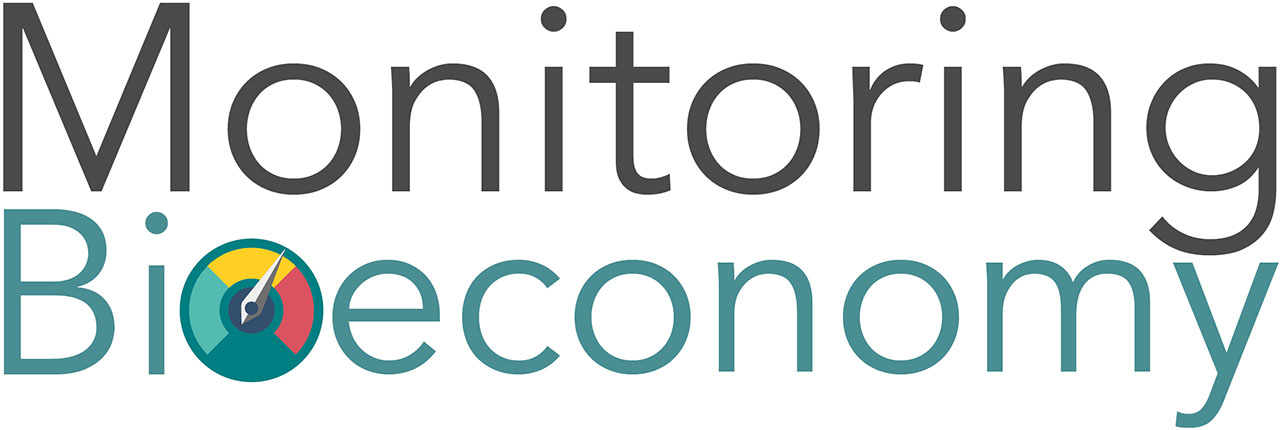What is the bioeconomy? I Chances and risks I Monitoring aims and needs I Indicators
The bioeconomy could help to achieve the future we want [1], if it is implemented in a way that unites multiple goals. The bioeconomy is seen as a way to reduce the consumption of non-renewable resources, ensure global food security, and promote local primary sectors (agriculture, forestry, fishing) as well as high-value manufacturing. But, if implemented poorly, it can also lead to harm. For example, increased demand for crops and timber can incentivize land use change that destroys biodiversity, releases carbon dioxide and violates human rights [2].
The bioeconomy is at the heart of fundamental challenges as regards the way we (a) use, manage and extract global resources and (b) use, trade, consume and recycle those resources within the economy. Monitoring from a systemic perspective is thus key to understand and develop a bioeconomy that meets Sustainable Development Goals [3].
What is the bioeconomy?
The bioeconomy is defined in the German bioeconomy strategy as “the production, exploitation and use of biological resources, processes and systems to provide products, processes and services across all economic sectors within the framework of a future-oriented economy“. The overarching aim is to combine economy and ecology to ensure a more sustainable use of resources [4].
The German Bioeconomy Council [5] calls for the coordinated promotion of technological, organizational and social innovations — as well as the transformation of markets and institutions — to strengthen social cohesion and achieve the vision of a sustainable and circular bioeconomy.
The bioeconomy includes all economic activities in which biomass is produced and used. This ranges from agriculture, forestry and fisheries to food, construction, paper, textile, energy, chemical and wood-product markets. Although currently small in size, expectations for new bio-based materials and applications (bioscience and biotechnology) [6] are high, in e.g. pharmaceuticals, cosmetics, plastics and nanotechnology. From a political perspective, the bioeconomy is a cross-cutting topic with ties to multiple policy areas, including: industry policy; energy policy; agriculture, forestry and fisheries policy; climate and environmental policy.
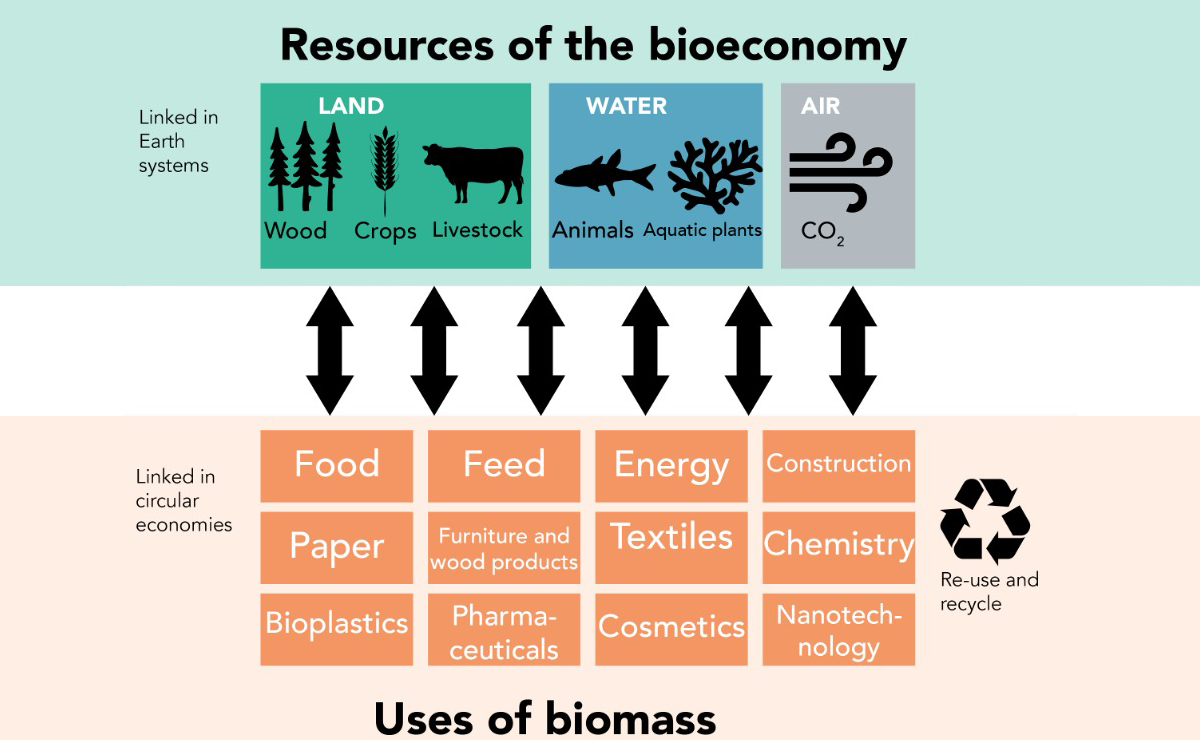
© AdobeStock: victorijareut; ahmad;
jeksonjs; fennywiryani; Natspace; Demarck; luisrftc
Resource base and uses of biomass in the bioeconomy (Source: Beck-O’Brien based on BMBF and BMEL (2020) [4], pp. 40).
Chances and risks
Narratives on the potentials and dangers of the bioeconomy differ widely [7]. These range from high levels of optimism (e.g. focused on industrial opportunities to defossilize the economy) to massive skepticism (e.g. focused on fair shares and ecological limits). The former sets high hopes on advancements in technical innovation and in some cases embraces concepts like GMOs, whereas the latter argues that decarbonization must be accompanied by social transformations (including concepts like sufficiency) to avoid problem shifting.
These narratives are connected to different expectations, and can make navigating the research landscape and deriving political implications complex. In the end, achieving the vision of a sustainable and circular bioeconomy requires finding common ground to maximize potentials while mitigating risks. It requires a deep and comprehensive understanding of the trade-offs and conflicts between forms of biomass use, interests and corresponding societal goals. Research programmes and initiatives are working hard to build this knowledge base, both within Germany and internationally [8].
Altogether, bioeconomy monitoring should provide facts and figures that allow opportunities and risks to be addressed. The aim of the monitoring is to provide comprehensive, significant and reliable information for the public and political debate.
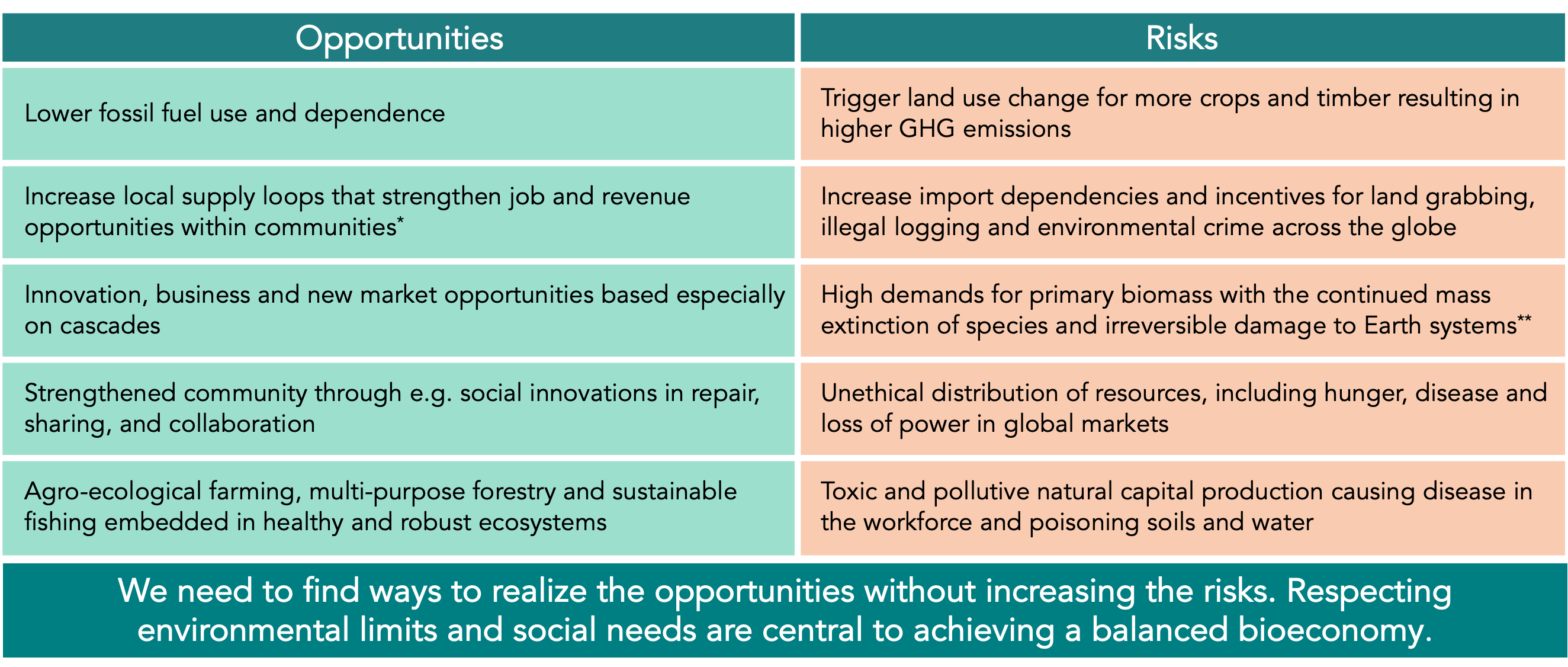
Opportunities and risks of the bioeconomy transition (Source: Beck-O'Brien)
* For example bioenergy communities. Read more at: https://www.bioenergie-kommunen.de
** For example in the way that climate systems interact and function. Nine planetary boundaries have been defined, of which at least 4 have already been exceeded or are in the zone of uncertainty. Read more at: https://www.stockholmresilience.org/research/planetary-boundaries.html
Why scale matters
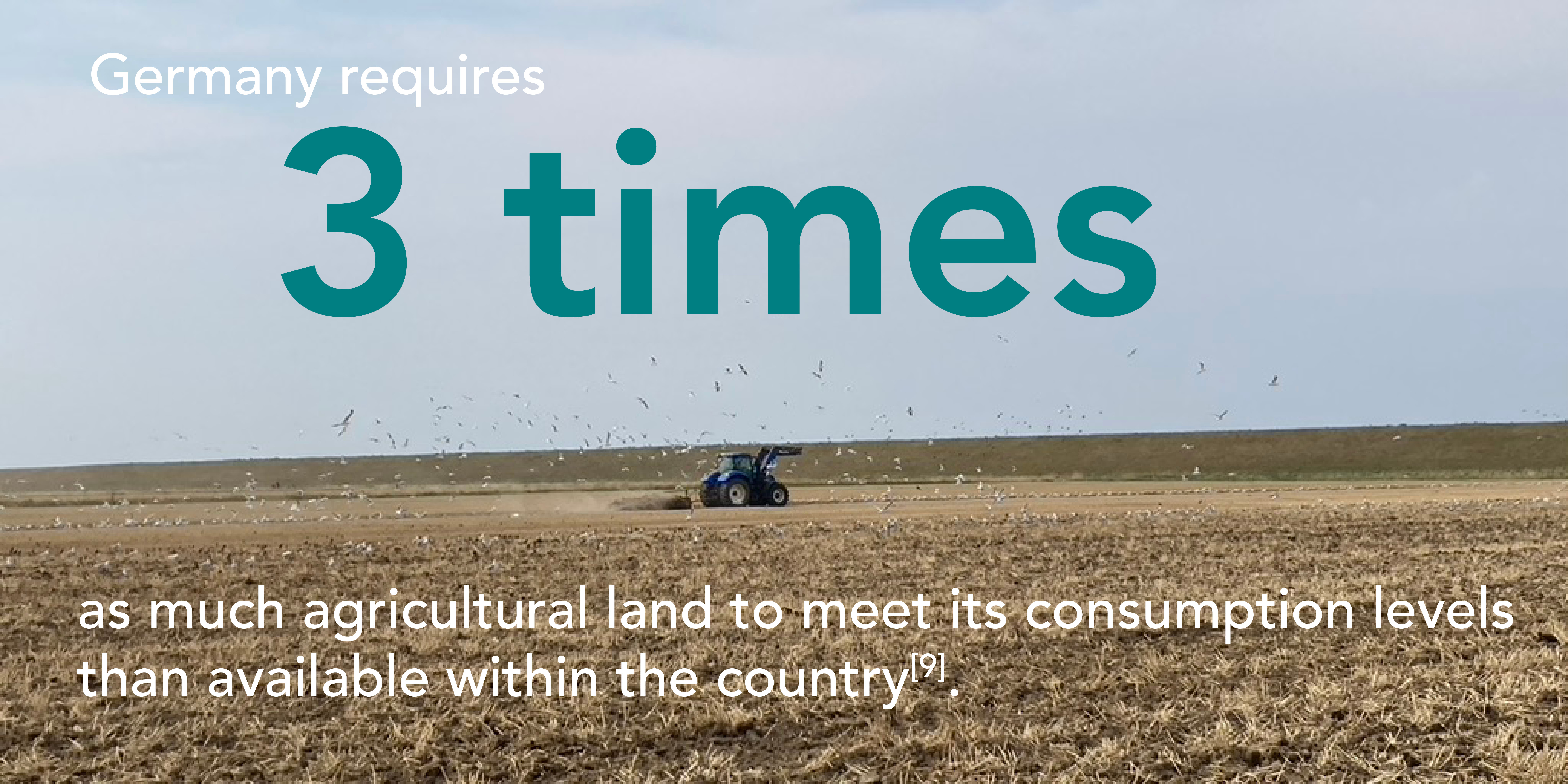
© Background image: Meghan Beck-O'Brien
Biomass can substitute fossil fuels, metals and minerals with a favorable ecological balance across the life-cycle of a single product [10]. For example, using engineered wood products instead of steel and concrete in construction generally lowers the embodied CO2 emissions of buildings [10]. However, if more of these products are produced and consumed, at some point, the amount of use may cause harms that outweigh the benefits.
Nearly one in three people suffer from food insecurity on our planet [11]. It is possible to feed to the world on available cropland [12] but not if everyone in the world were to eat in a way similar to average diets in Germany (with high levels of meat and dairy; e.g. more than 60% of agricultural land within Germany is used for producing animal feed). A growing world population also increases pressures on land for food production, on top of other uses. For example, around 1% of the total plastics market is currently made up of bioplastics (made from crops) [13]. With more than one-third of the food produced wasted or lost globally, and nearly two-thirds of plastic waste streams dominated by short-lived applications [14], the question is, how much of the food and plastics demand can be met with biomass, and how much can be cut through changed behaviors by business and consumers? This gets at the critical question for sustainably developing the bioeconomy: where is the balance between (a) resource extraction and production that are within ecological limits and (b) resource consumption levels [15]. Such questions must be answered to steer the transformation toward a balanced bioeconomy.
Monitoring aims and needs
The German National Bioeconomy Strategy outlines goals for monitoring: “The monitoring of the bioeconomy should help us better understand the development towards a sustainable bioeconomy. It should serve as the basis to evaluate steering and prioritisation at the policy level“ (BMBF and BMEL (2020) [4], pp.31).
This requires both a broad (cross-cutting and systemic) as well as deep (detailed and comprehensive) compilation of information, with different levels of detail needed for different purposes. It must be able to:
- Monitor the health of the biosphere — i.e. those ecosystems providing the resource base of the bioeconomy — across multiple levels (e.g. from landscapes to global climate systems) and the interactions between them in order to better understand potentials and limits
- Measure, monitor and evaluate the extraction of resources, including the economic, social and environmental sustainability of primary sectors (agriculture, forestry and fishing) and the synergies and trade-offs between them
- Track resource flows within the economy to understand where, how and what kinds of biomass are used as well as the market forces and policy interventions that drive them
- Connect consumption, production and extractive systems to better understand causal relationships, including the root causes and underlying drivers of environmental and social impacts, and to outline patterns of consumption which could be supplied sustainably
- Assess impacts from multiple scales, ranging from
- the micro: What is the impact at a product level?
- to macro: What are the impacts of national consumption levels on global earth systems and Sustainable Development Goals?
- Explore the potential consequences of ongoing trends and new decisions over time (synergies, conflicts, problem shifting and rebounds). This requires modelling and scenarios with data on both natural ecosystems and economic systems and the ways in which they interact
- Provide knowledge on drivers and barriers to innovation, especially as regards business models and social change toward a sustainable and circular bioeconomy, and their potentials and limits for up-scaling.
- Continuously include stakeholder perspectives on the status, development, risks and chances of the German bioeconomy as well as reflect societal values in the monitoring.
Altogether, the aim of bioeconomy monitoring is to develop a systemic framework that accounts for the bioeconomy as a whole, takes multiple levels of analysis into account in a dynamic way, and includes indicators and targets for evaluating the multiple facets of sustainability. The knowledge generated can be used to promote sustainable production practices, frame discussions on social norms and provide the impetus for policy interventions promoting the circular bioeconomy. While the monitoring detects and displays chances and risks, further research is needed to develop guidance toward steering the bioeconomy transition, including prioritization of how limited biomass resources should be best used (when does “food first” apply, what are the cases where material before energy use should be promoted). This requires knowledge on the ecological limits and innovation potentials. The data and indicators presented on this website are thus continually being updated, and we welcome opportunities for exchange to build and strengthen a systemic monitoring of the German bioeconomy that is at the forefront of the research landscape.
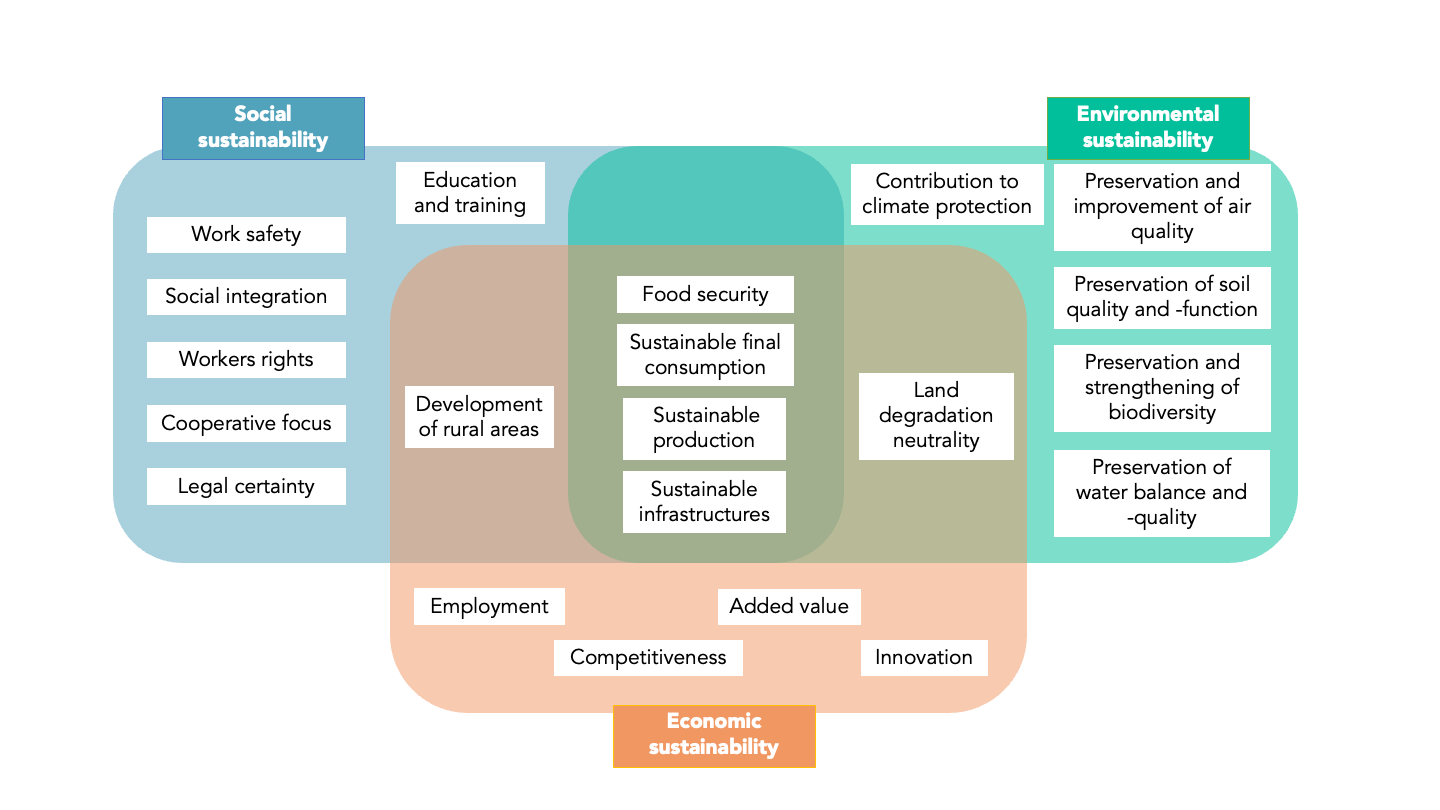
Dimensions of sustainability and goals that must be covered by systemic bioeconomy monitoring.
(Source: Egenolf und Bringezu (2019) [16]).
Indicators
Indicators provide information on the performance of a system such as the bioeconomy as a whole or the life-cycle of a selected product. Every indicator delivers answers only to a specific question. Headline indicators help to generate an overview. For example, resource and climate footprints provide information about the environmental ‘performance’ (level of burden) of the German or EU economy; similar to the indicator GDP as a key economic performance indicator. In contrast, indicators focused on questions such as ‘the fertility of agricultural soils’ may supply more detailed information. The basis for both detailed and headline indicators is extended data. An information pyramid may be observed across levels, from local to global scales [16].

Aggregation, scale levels and information flow of the indicator system. (Source: Egenolf and Bringezu (2019) [16]).
Indicators for measuring progress of the bioeconomy towards sustainability can be derived from the goals of implementation, such as contribution to climate change mitigation. The goals become operational via the attribution of criteria, such as emissions of climate gases, and the appropriate indicator would then be the amount of CO2-equivalents emitted by the system monitored [16]. When goals, criteria, and indicators have been defined, the system boundaries and the spatial and temporal scope need to be defined. A life-cycle or systems-wide boundary means that the indicators reflect the whole process chain (from harvest to use and final disposal). For example, the spatial scope may require that activities undertaken in Germany are monitored with regard to their global impacts, and the temporal scope may require using the most actual data available and/or performing some trend analysis. Finally, indicators on their own may need to be compared to appropriate reference values [17]. For example, the indicator on ‘fertility of agricultural soils’ needs a comparative reference to judge when soil fertility is considered high or deficient (or on a scale in-between). Such an assessment may also consider science-based target values for sustainability [18].
The indicators to be monitored for the German bioeconomy need to reflect the SDGs [19] as well as particular expectations of the German populace. For example, stakeholder participation in three workshops revealed that the contribution to sustainable production and consumption (SDG 12), climate protection (SDG 13) and sheltered life in water and on land (SDGs 14 and 15) are regarded as high priority goals [20]. Consequently, indicators providing information about whether the activities within the German bioeconomy contribute toward meeting these goals both domestically and globally are of high relevance for the monitoring. Thus, indicators on climate, land and water footprints of the biobased production and consumption in Germany constitute a core element of the monitoring (see national consumption footprints).
Finally, a monitoring system requires a continuous accounting over time to provide policy relevant information on trends and progress. The following figure describes the consecutive steps of a monitoring cycle for the bioeconomy — as implemented in the MoBi Project of Thünen Institute [17]. It requires clarity on the goals for indicators — in the context of policy aims, markets developments and societal perceptions — and these must be reviewed and operationalized in every monitoring cycle. The figure below depicts an approach to monitor both (1) biomass flows (from agriculture, forestry and fisheries) and (2) the development of bioeconomy sectors (in particular using socio-economic indicators). It includes the consequtive steps of data collection, quantification (in indicators), sustainability assessment, and definition (review and operationlisation) [17].
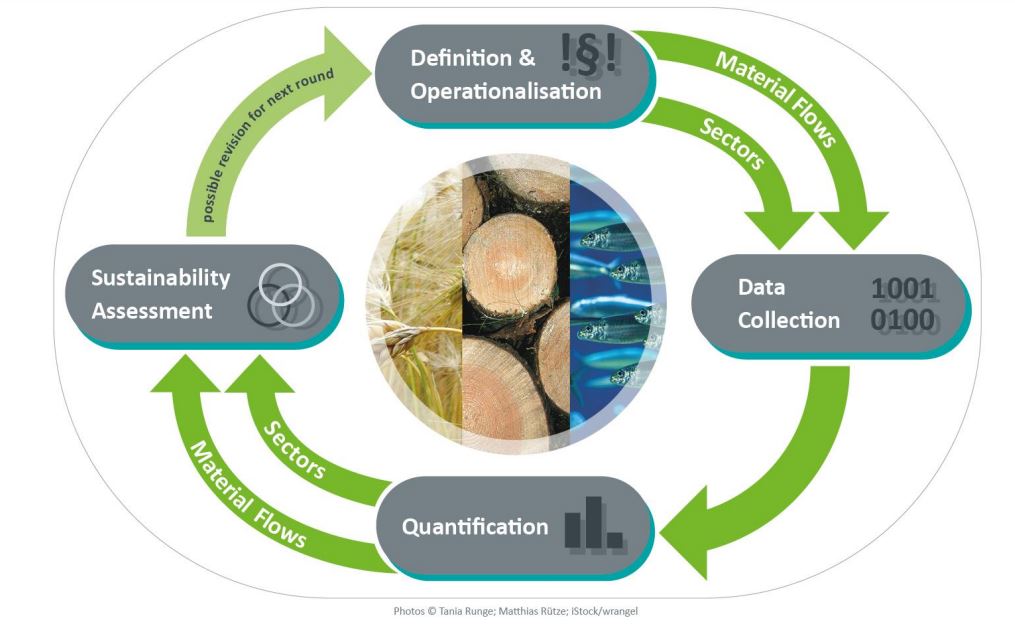
© Tania Runge; Matthias Rütze; iStock/wrangel
Consecutive steps of bioeconomy monitoring (Source: Iost et al. (2020) [17], pp.15).
Notes and references
- The bioeconomy can and must be used to reach the UN Sustainable Development Goals and reach the vision described in the Declaration of the UN Conference on Sustainable Development in Rio (2012) on the “Future We Want”. Available at: https://sustainabledevelopment.un.org/futurewewant.html.
- For an overview of concerns see e.g. the short paper: Fatheuer (2018). The bioeconomy controversy: Considering the bioeconomy from a development policy perspective. Available at: https://www.fdcl.org/wp-content/uploads/2018/05/The-Bioeconomy-Controversy.pdf. The Land Portal provides detailed information on all issues related to global land governance: https://landportal.org.
- 17 Sustainable Development Goals are used as indicators for reaching Agenda 2030 and reflect commitments by governments across the Earth to implement sustainability in markets and society. See also: https://sdgs.un.org/goals
- BMBF and BMEL (2020). The National Bioeconomy Strategy. Available at: https://www.bmel.de/EN/topics/farming/bioeconomy-renewable-resources/national-bioeconomy-strategy.html
- They are an independent advisory body to the German government, which engages in a participatory exchange with society, industry and interest groups in order to develop recommendations for action to implement the National Bioeconomy Strategy. See their website: https://www.biooekonomierat.de/en/ and the first working paper of the third Bioeconomy Council (2022). Bioeconomy: Creating a sustainable future together. Available at: https://www.biooekonomierat.de/publikationen/positionen/2022/arbeitspapier.php.
- Examples showing the scope of innovation from research and development activities across Germany are available on the website: https://biooekonomie.de/en/funding/success-stories
- See the project: Change in perspective Bioeconomy – for more sustainability. Available at: https://www.ioew.de/en/project/change_in_perspective_bioeconomy_for_more_sustainability; the info flyer: How sustainable is the bioeconomy really? Available at: https://www.ioew.de/fileadmin/user_upload/BILDER_und_Downloaddateien/Publikationen/2021/PeWeBO_Wie_nachhaltig_ist_die_Biooekonomie_wirklich_bf.pdf; and the Podcast: Bioeconomy — Model for the future or empty promise? Available at: https://www.bund.net/ressourcen-technik/biooekonomie/#c22002.
- In addition to national initiatives efforts are ongoing at the EU (e.g. https://knowledge4policy.ec.europa.eu/bioeconomy/monitoring_en) and global levels (e.g. the FAO and the World Bioeconomy Forum)
- Bringezu et al. (2021). Environmental and socioeconomic footprints of the German bioeconomy. Nat. Sustain. doi: 1038/s41893-021-00725-3
- Verkerk et al. (2021). The role of forest products in the global bioeconomy – Enabling substitution by wood-based products and contributing to the Sustainable Development Goals FAO. doi: 10.4060/cb7274en. However, scale also matters. Not all new buildings can be built with wood in Germany —under current levels of total consumption — without disproportionately increasing Germany’s burden on global forests. Monitoring is needed to help determine where the appropriate balance lays.
- FAO et al. (2022). The state of food security and nutrition in the world. Available at: https://www.fao.org/3/cc0639en/online/cc0639en.html .
- Food insecurity today is primarily a result of poverty, inequality and disrupted markets. Yet, to feed the world sustainably, the western diatery patterns with a large animal-based share need to shift towards a more plant-based diet. The “planetary health diet” (available at: https://eatforum.org/eat-lancet-commission/the-planetary-health-diet-and-you) was developed to meet both nutritional requierements and planetary boundarie Willett et al. (2019). Food in the Anthropocene. The EAT–Lancet Commission on healthy diets from sustainable food systems. The Lancet. doi: 10.1016/S0140-6736(18)31788-4. See Food and Feed for further reading.
- The mass of plastics on the planet is now more than double the mass of all living mammals, and it is accelerating. Persson et al. (2022). Outside the Safe Operating Space of the Planetary Boundary for Novel Entities. Environ. sci. & tech. doi: 10.1021/acs.est.1c04158. At the same time, suggested policy measures in a system change scenario for plastic packaging show a potential to reduce new plastic demand by 64% by 2040 in Germany — Halfmann et al. (2021). Verpackundwende jetzt! So gelingt der Wandel zu einer Kreislaufwirtschaft für Kunstoffe in Deutschland. Available at: https://www.wwf.de/fileadmin/fm-wwf/Publikationen-PDF/Unternehmen/WWF-Studie-Verpackungswende_jetzt_-_So_gelingt_der_Wandel_zu_einer_Kreislaufwirtschaft_f%C3%BCr_Kunststoffe_in_Deutschland.pdf. Note: this scenario combines measures like avoiding unnecessary packaging, increased recycling as well as substituting plastic for paper. However, the latter should only be implemented in conjunction with sufficiency measures and under specific criteria (for applications that make ecological sense) to avoid problem shifting (e.g. associated with an increased demand for paper). This underscores the need for taking a systems perspective and addressing business needs, social norms and regulatory frameworks together.
- See the Global Plastics Outlook by the OECD, with the second report released in 2022; https://www.oecd.org/environment/plastics/
- The question is: How should a "fair share” be defined? Research to answer this question can be found at e.g. the Science-based targets network (Available at: https://sciencebasedtargetsnetwork.org/) or for the Earth Commission in the ongoing work of Bai et al. (2022). How to stop cities and companies causing planetary harm. Available at: https://www.nature.com/articles/d41586-022-02894-3. Furthermore, how would and/or could this contribute to the challenge of distribution and what other measures would be needed?
- Egenolf and Bringezu (2019). Conceptualization of an Indicator System for Assessing the Sustainability of the Bioeconomy. Sustain. doi: 10.3390/su11020443.
- Iost et al. (2020). Setting up a bioeconomy monitoring: Resource base and sustainability. Thünen Working Paper 149. doi:10.3220/WP1593762669000.
- For example at the global scale see the suggested benchmarks in Bringezu (2022). The World Budget - Safe and fair resource use for global survival and well-being.
- The “Sustainable Development Goals” (SDGs) are the 17 goals of the United Nations 2030 Agenda for sustainable development. Available at: https://sdgs.un.org/goals
- Zeug et al. (2019). Stakeholders’ Interests and Perceptions of Bioeconomy Monitoring Using a Sustainable Development Goal Framework. Sustain. doi: 10.3390/su11061511
